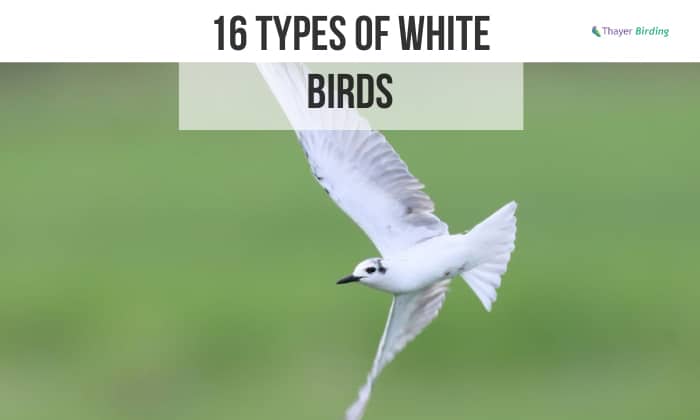Generally, there are two common types of white birds: birds that live near water and birds that live in snowy habitats.
Water birds are white in order to blend in with clouds when viewed from below. Their white feathers also help them stay cool in the hot sun.
Similarly, arctic birds are white so that they can’t be spotted by predators, or preys, in their native snow environment.
So, what are some examples of birds with white feathers in these two categories, and are there any others? Read on to learn about these amazing birds, and their pictures and names!
Table of Contents
- List of White Birds in Nature
- 1. American White Pelican (Pelecanus erythrorhynchos)
- 2. White Tern (Gygis alba)
- 3. Great Egret (Ardea alba)
- 4. Cattle Egret (Bubulcus ibis)
- 5. White Ibis (Eudocimus albus)
- 6. Trumpeter Swan (Cygnus buccinator)
- 7. Tundra Swan (Cygnus columbianus)
- 8. Whooping Crane (Grus americana)
- 9. Snow Goose (Anser caerulescens)
- 10. Red-tailed Tropicbird (Phaethon rubricauda)
- 11. Royal Spoonbill (Platalea regia)
- 12. Ivory Gull (Pagophila eburnea)
- 13. White-tailed Ptarmigan (Lagopus leucura)
- 14. Rock Ptarmigan (Lagopus muta)
- 15. Snowy Owl (Bubo scandiacus)
- 16. White Cockatoo (Cacatua alba)
- Conclusion
List of White Birds in Nature
Here is a list of white birds in nature.
1. American White Pelican (Pelecanus erythrorhynchos)
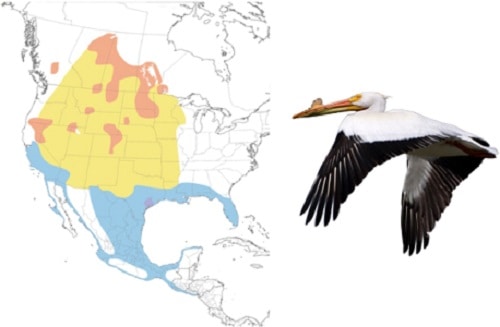
American white pelican in breeding season
- Size: 50-70 inches
- Wingspan: 95-120 inches
- Lifespan: At least 16 years
- Status: Least Concern
- Distribution: North America
The American white pelican is a big aquatic bird measuring 50-70 inches in length with a wingspan of 95-120 inches. They have white feathers with black flight feathers hidden under their wings.
A distinguishing feature of these birds is their big yellow bills which take up 10-15 inches of their body length. These bills are flat on top with an expandable sac at the bottom, which can hold up to three gallons of water and is perfect for fishing!
During the breeding season, these bills grow small “horns” near the tip.
These birds will always be found near water, whether wintering along the coast or spending breeding seasons inland near rivers, lakes, marshes, and bogs.
2. White Tern (Gygis alba)
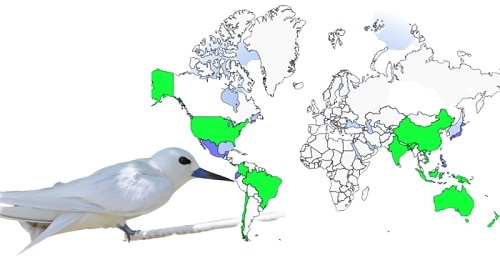
- Size: 12 inches
- Wingspan: 30-34 inches
- Lifespan: 16-18 years
- Status: Least Concern
- Distribution: Islands along tropical oceans
Because of their pure-white plumage, white terns are also known as fairy and angel terns. In 2007, these pretty white birds were declared the official bird of Honolulu, Hawaii, where they are known as Manu-o-Kū.
White terns are about 12 inches long with a wingspan of 30-34 inches. They are found in islands and countries along tropical oceans, particularly the Pacific Ocean. These birds primarily eat small fish, which even their chicks can swallow whole!
While they typically live along the coast, they move inland to breed in forests. Interestingly, these birds do not build nests; instead, females lay one egg at a time directly on a tree’s branch fork.
3. Great Egret (Ardea alba)
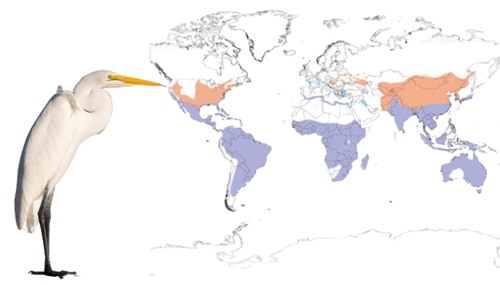
- Size: 31-41 inches
- Wingspan: 52-67 inches
- Lifespan: 15 years
- Status: Least concern
- Distribution: Asia, Africa, Europe, North America, South America
The great egret, also known as the great white heron, are birds that look like cranes. They have long necks, typically body length of 31-41 inches, and a wingspan of 52-67 inches. When standing upright, they are over 3 feet tall!
Great egrets typically have all-white plumage and a yellow bill. However, their appearance changes slightly during breeding season when their bill darkens to black, and they grow ornamental back feathers.
These big white birds can be found on all five continents: Asia, Africa, Europe, and North and South America.
Wherever they are, they must be near fresh or saltwater. This requirement is so non-negotiable that it is their criteria for deciding where to winter: great egrets will go wherever water is flowing!
4. Cattle Egret (Bubulcus ibis)
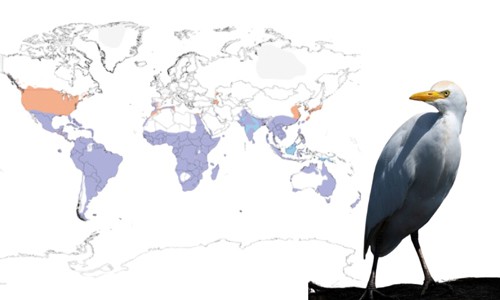
- Size: 19-21 inches
- Wingspan: 36 inches
- Lifespan: 20 years
- Status: Least Concern
- Distribution: Asia, Africa, Europe, Australia, Americas
Cattle egrets got their name from frequently being spotted perched on the backs of cattle and other large animals. While the birds get food (ticks and flies), the cattle get a reprieve from insects—it’s a perfect symbiotic relationship.
Cattle egrets are small herons. They are about 19-21 inches long, with a maximum wingspan of 36 inches.
While these egrets remain white for most of the year, they sprout orange head and chest feathers during the breeding season to attract mates.
These birds are native to Asia, Africa, and Europe but have spread to the Americas and Australia over the last century. While they love water as much as other egrets do, they don’t shy away from living in drier places such as grasslands and pastures.
5. White Ibis (Eudocimus albus)
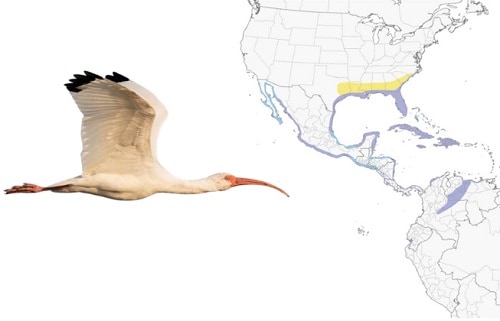
- Size: 21-28 inches
- Wingspan: 35-41 inches
- Lifespan: 16-20 years
- Status: Least Concern
- Distribution: southern North America and central America
White ibises live near the coast, where they can be near water, their favorite habitat, and prey such as fishes, crustaceans, and insects.
They can mainly be found along the southern coast of the US and Central America, with the biggest population living in Florida.
These water birds are typically 21-28 inches long with a wingspan of 35-41 inches. They have white feathers, long orange legs, and a long, curved, red-orange bill which they use to forage for food by using them to feel around shallow water for the fish. When in flight, their black wingtips are visible.
White ibises are quiet birds that don’t utter anything more than a few occasional grunts and croaks!
6. Trumpeter Swan (Cygnus buccinator)
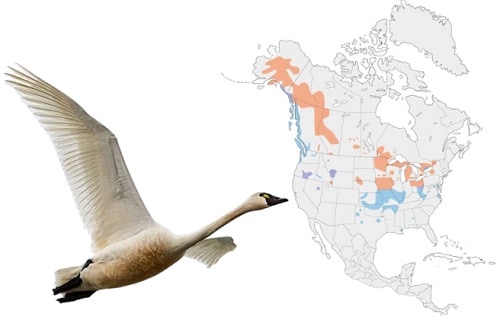
- Size: 4.5-5.5 feet
- Wingspan: 6-8 feet
- Lifespan: 25 years
- Status: Least Concern
- Distribution: North America
The trumpeter swan is the largest waterfowl species in America. Its body is 4.5-5.5 feet long, while its fully-extended wings can span 6-8 feet!
These large white birds are largely vegetarian, mostly subsisting on aquatic plants, like roots and tubers.
They live anywhere near water, such as wetlands, ponds, and marshes, but can also be seen wandering around prairies. Trumpeter swans can be found along the coast of Alaska and Canada; however, they migrate further inland during breeding and wintering seasons.
These birds have all-white feathers with a black bill. Curiously, some trumpeter swans develop an orange tinge along their neck because of the iron in the mud and water of their habitat.
Trumpeter swans symbolize grace, beauty, and serenity. In some cultures, they are also a symbol of fidelity because of their monogamous lifestyle.
7. Tundra Swan (Cygnus columbianus)
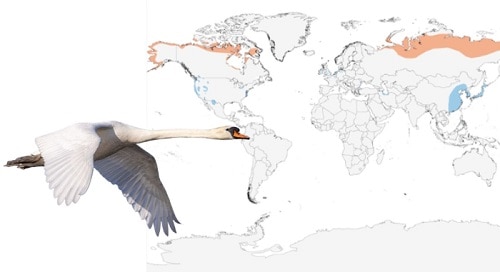
- Size: 4-5 feet
- Wingspan: 5-7 feet
- Lifespan: 20 years
- Status: Least Concern
- Distribution: Arctic regions; northern North America, China, Japan
Tundra swans look similar to trumpeter swans with the same white plumage, but their black bills turn yellow by the base. They are also smaller at 4-5 feet long with a wingspan of 5-7 feet.
These swans are sometimes referred to as whistling swans because of the sound that their wings make during flight.
Tundra swans are normally found in arctic regions in the summer, but flock southward during the colder parts of the year. When not in tundras, you can find these swans near water sources, such as by the coastline or estuaries, or in agricultural fields.
This long-necked bird spends a lot of time in the water, even sleeping afloat. They also rely on these bodies of water for the meals, picking underwater fishes, shellfishes, and plants with their long necks.
8. Whooping Crane (Grus americana)
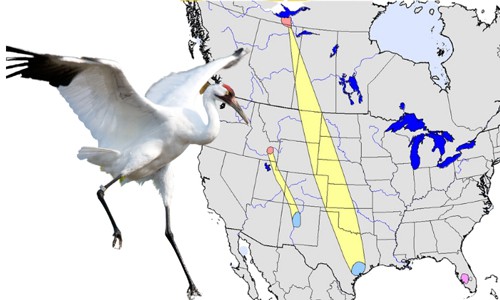
- Size: 4 feet – 5 feet, 3 inches
- Wingspan: 6 feet, 7 inches – 7 feet, 7 inches
- Lifespan: 22-24 years
- Status: Endangered
- Distribution: North America
Whooping cranes are North America’s tallest bird, standing between 4 feet to 5 feet and 3 inches in height. They also have huge wingspans of 6 feet 7 inches to 7 feet 7 inches.
This white bird species has a black mask and a red patch on their foreheads.
These cranes primarily fly back and forth between Canada and Texas between seasons, though a small population lives in Florida year-round.
Whooping cranes are named after their loud whooping calls that can be heard up to two miles away. They are also known for their elaborate courtship dances that involve flapping, leaping, running, bowing, and more.
9. Snow Goose (Anser caerulescens)
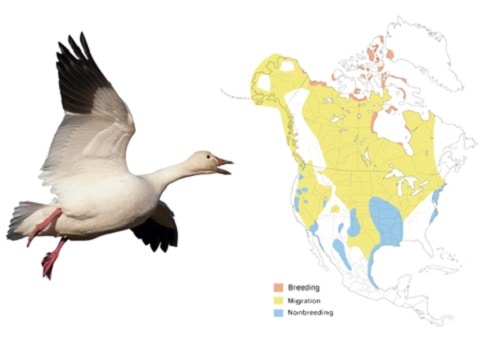
- Size: 27-33 inches
- Wingspan: Up to 56 inches
- Lifespan: 20 years
- Status: Least concern
- Distribution: Primarily northern North America and Russia
While snow geese are often all white with black wingtips, some members of the family come in a dark morph with brownish feathers. These dark morph snow geese are known as blue geese.
Snow geese are fairly large with a body length of 27-33 inches and wingspan of up to 56 inches.
These birds breed far north at the furthest edges of Alaska, Canada, and Greenland, but fly south to several US states during winters. While travelling, they mark the skies with their distinct V-pattern.
People often spot these geese near water, such as along the coast and in marshes, bays, and wet fields. They spend much of their time happily standing around, eating grasses, grains, and seeds–sometimes as much as 1kg of plants in a day!
10. Red-tailed Tropicbird (Phaethon rubricauda)
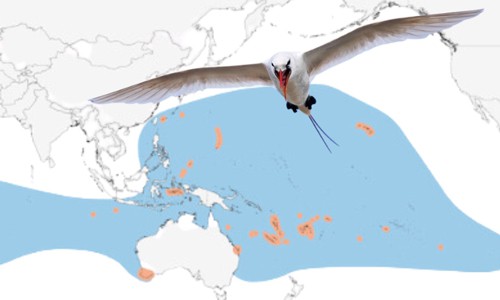
- Size: 37-41 inches
- Wingspan: 44-47 inches
- Lifespan: 16-23 years
- Status: Least Concern
- Distribution: Around Indian and Pacific Oceans
Red-tailed tropicbirds live around the warm waters of the Indian and Pacific Oceans, favoring a temperature between 75 to 86 °F. They are often spotted diving into the water to catch fish and squid and typically reemerge after having swallowed their prey.
These seabirds are fairly large, with bodies 37-41 inches long, inclusive of their two red 14-inch tails. Its wingspan is usually 44-47 inches. They are beautiful white birds with black eye masks, and bright red tails and bills.
Being aquatic white birds that fly, red-tailed tropicbirds look rather awkward while on land, shuffling around with a lopsided gait. They typically build their nests on cliffs, low banks, and coral atolls or islands with lagoons at the center where corals can grow.
11. Royal Spoonbill (Platalea regia)
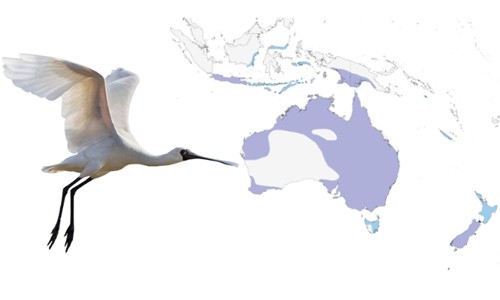
- Size: 31 inches tall
- Wingspan: 47 inches
- Lifespan: 15-30 years
- Status: Least Concern
- Distribution: Australasia
Royal spoonbills are also known as the black-billed spoonbill. They are mainly found around Australia and surrounding regions.
As their name suggests, they have long, flat, wide bills that resemble spoons. Standing at 31 inches tall, these birds have long legs that they use to wade through water. Their wingspan is typically 47 inches.
During the breeding season, these birds grow long white neck-feathers that can be raised like a crest.
This bird lives in wetlands, mudflats, and wet grasslands with no preference for either fresh or saltwater, natural or artificial structures. Being a carnivorous species with long beaks, it can be frequently spotted fishing for aquatic animals.
12. Ivory Gull (Pagophila eburnea)
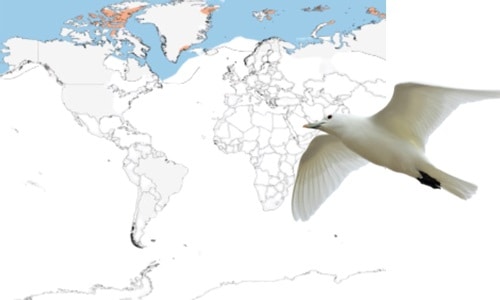
- Size: 16-17 inches
- Wingspan: 42-47 inches
- Lifespan: 10-20 years
- Status: Near threatened
- Distribution: Arctic region
Ivory gulls are found exclusively in the far north of the planet. Their scientific bird names roughly translate to “ivory-colored lover of sea ice.”
They have pigeon-shaped bodies and are 16-17 inches long with a wingspan of 42-47 inches. They also have unique blue-green bills tipped with yellow in the winter but turn red during breeding season.
These birds are aggressive scavengers, eating carrion and waste left over by other animals. However, they sometimes hunt for themselves, eating fish, eggs, rodents, and small chicks.
Ivory gulls nest on cliffs, beaches, and islets of floating ice where they live in massive, noisy colonies.
13. White-tailed Ptarmigan (Lagopus leucura)
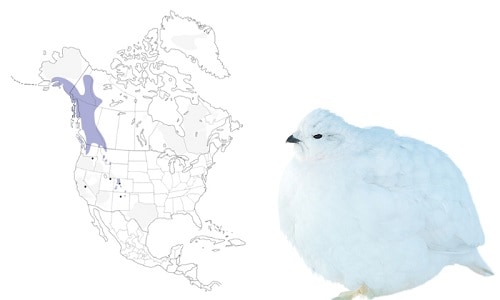
- Size: 12 inches
- Wingspan: 17-20 inches
- Lifespan: 3-4 years
- Status: Least Concern
- Distribution: northern North America
White-tailed ptarmigan are also known as snow quail. They thrive in high altitudes in Alaska, mountainous parts of Canada, and select western US states. They are small birds, about 12 inches long with a wingspan of 17-20 inches.
These tiny white birds are built for their environment. Their feathered feet allow them to walk on top of snow, bury themselves in snow, and to build snow dens to keep warm in their treacherous cold habitat
While they are pure-white in the winter, these birds turn gray and brown in the summer to blend in better with their surroundings. Males have thin red lines over their eyes.
White-tailed ptarmigans are vegetarians, munching on leaves, seeds, flowers, and buds for most of the day.
14. Rock Ptarmigan (Lagopus muta)
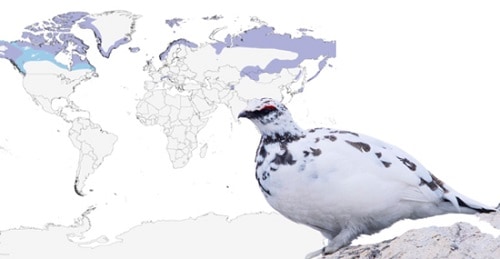
- Size: 13-14 inches
- Wingspan: 21-24 inches
- Lifespan: 2-4 years
- Status: Least Concern
- Distribution: northern North America, Europe, and Russia
The rock ptarmigan is the official bird of the Nunavut region of Canada.
These small white birds look like a cross between a chicken and a dove. They are 13-14 inches long with a wingspan of 21-24 inches. Like other ptarmigans, they have all-white plumage during winter that shift to brown for the summer.
However, male rock ptarmigan transition their colors later, often staying all-white much longer than females. Curiously, to stay safe, male rock ptarmigan get dirty to appear browner.
Rock ptarmigan can be spotted in the rocky, dry areas of tundras. They are often found near, and confused with, willow ptarmigan, another white bird.
Adults are generally vegetarian, eating berries, buds, leaves, and flowers at different times of the year. Chicks tend to eat more meat, from insects to larvae to snails.
15. Snowy Owl (Bubo scandiacus)
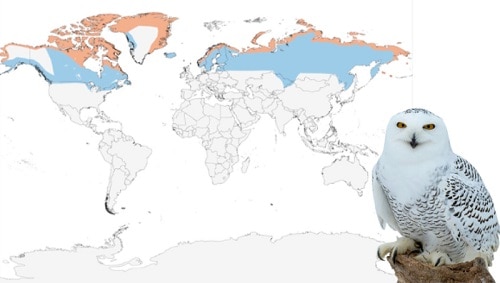
- Size: 21-25 inches
- Wingspan: 60 inches
- Lifespan: 10 years
- Status: Vulnerable
- Distribution: northern North America, Europe, and Russia
Snowy owls are also known as the polar, white, and Arctic owl.
It spends its entire life in the northern tundra regions flying over open terrains or perching on hay bales, fence posts, or dunes. When out of the tundra, these white birds of prey can be found near lakes, the ocean, and in agricultural fields.
Male snowy owls are nearly all-white, while females and juveniles are marked with dark flecks. It is a large species at 21-25 inches long with an average wingspan of 5 feet.
Snowy owls are active during the day, unlike most other owl species. They are carnivores with a preference for lemmings. Aside from these rodents, owls will also eat rabbits, birds, and fish.
Snowy owls became wildly popular in pop culture because of Hedwig, Harry Potter’s pet.
16. White Cockatoo (Cacatua alba)
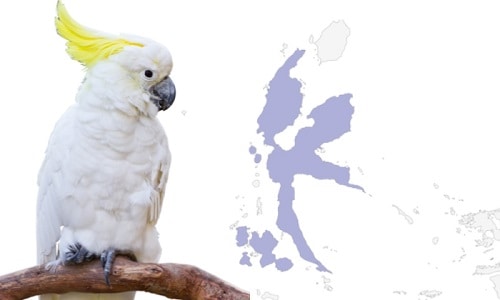
- Size: 18 inches
- Wingspan: 9-12 inches
- Lifespan: 40-50 years
- Status: Endangered
- Distribution: Indonesian archipelago
White cockatoos are also known as umbrella cockatoos because of their broad head crests, similar in shape to umbrellas.
These white pet birds are around 18 inches long with a wingspan of 9-12 inches. While they are outwardly completely white, they have some yellowish inner wing feathers.
White cockatoos are endemic to the Indonesian islands where they live in forests, mangroves, swamps, and agricultural fields. They are primarily herbivores that eat nuts, seeds, and fruit, but will occasionally eat insects and lizards.
As with all cockatoos, these are birds that talk if trained. In nature, they often make loud, screechy calls to communicate with each other.
Conclusion
There is simply something captivating about seeing pristine white plumage with your own eyes. There is a reason why white birds have long been associated with peace, purity, and new beginnings.
While it may be difficult to see a wild ivory gull or white cockatoo for yourself, there are, thankfully, also lots of white water birds that live in more accessible areas.
If you aren’t particular about seeing pure-white types of white birds, there are many mostly white birds more common in urban areas!

As many can agree with me, birdwatching is a thrilling and calm hobby at the same time. Such trips to the parks into deeper parts of the jungle bring me enormous joy seeing the birds through my naked eyes or high-quality camera and binoculars. So, to make such a hobby even more enjoyable to you, beginners or not, I opened this space called Thayerbirding.


